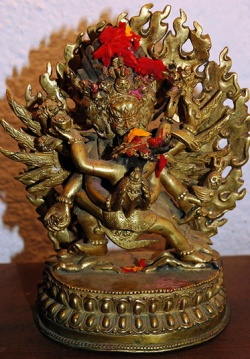Vajrakilaya (also known as Vajrakumara)
Vajrakilaya (also known as Vajrakumara) is the deity of the magic thundernail, the kīla, a tool of the sharp adamantine point of dharmakaya, a wisdom forded through the power of one-pointed concentration. This 'one-pointed' (Sanskrit: eka graha) focus is a concerted mindfulness on the unity and interdependence of all dharmas. This one-pointed focus is understood as 'applying oneself fully' (Tibetan: sgrim pa). Vajrakilaya is a favoured tantric archetypal deity embraced by the Nyingmapa. The awesome and wrathful manifestation of this empty yet apparent deity assists practitioners in clearing the obstructions to realisation.
A common manifestation of Vajrakilla has three heads, six arms, and four legs. Vajrakilaya's three right hands except for the right front one held vajras with five and nine prongs. The right front one makes a mudra as granting boons with open palm. Vajrakilaya's three left hands hold a flaming triple wishfulfilling jewel or triratna, a trident and the kilaya. Vajrakilaya's back is covered by the freshly flayed skin of the elephant representing 'ignorance' (Sanskrit: avidya; Wylie: marigpa), with the legs tied in front. A human skin is tied diagonally across his chest with the hands lying flat on Vajrakilaya's stomach and solar plexus representing the flailed ego that has released its powerful grip obscuring the 'qualities' of the Sadhaka.[14] Qualities are represented iconographically by the 'vortex' (Sanrkit: chakra; Wylie: Khorlo) of the Manipura (Sanskrit: Maṇipūra). A rope ripples over his body with severed heads hanging by their hair representing the Akshamala or 'garland of bija' (Sanskrit: Varnamala). A knee length loin cloth winds around his belly belted with a tiger skin complete with tail, claws and head. This deity wears manifold nāga adornments and jewellery: naga earrings, naga bracelets, naga anklets and a naga cord over his chest, sometimes referred to as a naga gurdle and a naga hairpiece or hair ornament. Vajrakilaya's faces are round and small compared to the tall body. Despite the large fangs and bulging eyes and his wrathful appearance, Vajrakilaya is perceived as having a benevolent demeanor.
Vajrakilaya is a wrathful manifestation of Vajrasattva, the buddha of purification. The practice of Vajrakilaya focuses on removing intense inner and outer obstacles to peace, happiness, and enlightenment.
In today’s difficult times, anxieties about our personal life and world conditions can create disturbing thought-forms within us. With billions of people consumed by the same concerns, our shared thought-forms create an interwoven web of great turmoil around the world. This can give rise to afflictive emotions, creating inner obstacles to spiritual practice and happiness, which, in turn, manifest as outer obstacles in life. Vajrakilaya practice is especially helpful and suitable during this time, both for individual practitioners and for the well-being of the world community as a whole. And it is a perfect way to prepare for the New Year.
“Drubchen” means “great accomplishment” in Tibetan and is one of the most elaborate forms of Vajrayana Buddhist practice. A drubchen is a rare opportunity to concentrate body, speech, and mind in spiritual application, resulting in realization and merit to sustain spiritual development in this and future lives. Sincere participation in a drubchen is said to generate merit and potential realization equal to one year of retreat. Dedicating the practice to all sentient beings extends this benefit and enhances world peace and prosperity.
The Vajrakilaya empowerment will be given the first morning, but is not required to participate in the drubchen, and no prior experience in the practice is necessary. You may attend part or all of the drubchen as your schedule permits, and the empowerment may be attended separately from the drubchen.
The kīla (Sanskrit Devanagari: कील; IAST: kīla; Tibetan: ཕུར་བ, Wylie: phur ba, pronunciationThe Phurba (Vajrakilaya) chakra contains the essence, power and protection of Vajrakilaya, the wrathful Buddha that clears obstacles, especially those that are related to spirits. The Phurba is a ritual dagger that represents Vajrakilaya.
As Vajrakilaya is a wrathful and protective form of Guru Rinpoche, his energies represent the unchangeable and indestructible, which is enlightenment itself and also eliminates ignorance, greed and hatred in the long run. As it is the energy of an enlightened being, the chakra also has the ability to provide protection as well as transforming negative spirits and emotions into positive ones. between pur-ba and pur-pu, alt. transliterations: phurpa, phurbu or phurpu) is a three-sided peg, stake, knife, or nail like ritual implement traditionally associated with Indo-Tibetan Buddhism, Bön, and Indian Vedic traditions. The kīla is associated with the meditational deity (Srkt:ishtadevata, Tib. yidam) Vajrakīla ( वज्रकील) or Vajrakīlaya (Tib. Dorje Phurba).
